At TrustPoint Hospital we believe education is an important first step in the effort to heal from depression. Understanding the signs, symptoms, and effects of depression can help you get the right type and level of care for yourself or a loved one.
Understanding Depression
Learn about depression
Moments of sadness, frustration, and even temporary feelings of despair are common experiences that, while painful, are parts of a healthy life. However, if feelings like these endure for extended periods of time, or occur with such intensity that a person finds it difficult to function in a healthy and productive manner, then that person may have developed a depressive disorder.
Depressive disorders, which are often informally referred to by the blanket term of depression, are a group of disorders with symptoms that include intense sadness, emptiness, and/or irritability, along with disrupted cognition and somatic impact. The following are four of the more common types of depressive disorders:
Major depressive disorder: To be correctly diagnosed with this form of depression, a person must experience five or more of the following symptoms, most of the day, nearly every day, for two weeks, with the symptoms causing significant distress or functional impairment:
- Depressed mood
- Recurrent thoughts of death, suicidal ideation, planning for suicide, or attempting suicide
- Indecisiveness or diminished ability to think or concentrate
- Hypersomnia or insomnia
- Psychomotor retardation or agitation
- Markedly diminished interest or pleasure in all or most activities
- Significant change in appetite or unintentional change in weight
- Fatigue or loss of energy
- Feelings of worthlessness and/or excessive or inappropriate guilt
Persistent depressive disorder: To be correctly diagnosed with persistent depressive disorder, a person must experience depressed mood most of the day, for most days, for at least two years, with no asymptomatic period that lasts for more than two months. The person must also have a minimum of two of the following symptoms:
- Fatigue or low energy
- Significantly increased or decreased appetite
- Disrupted sleep patterns, including insomnia or hypersomnia
- Poor concentration and/or problems making decisions
- Sense of hopelessness
- Poor self-esteem
Premenstrual dysphoric disorder: Anxiety, dysphoria, mood lability, and irritability that occur during the premenstrual phase and that dissipate during the onset of menses are the fundamental characteristics of premenstrual dysphoric disorder. To be correctly diagnosed with premenstrual dysphoric disorder, a woman must have experienced five of the following symptoms, including at least one from each group, during most of her menstrual cycles over the previous 12 months:
Group 1
- Depression, hopelessness, and self-deprecating thoughts
- Mood swings or increased sensitivity to rejection
- Increased irritability or anger
- Anxiety, tension, and/or feelings of being on edge
Group 2
- Significant change in appetite, which may include overeating or specific food cravings
- Sense of being overwhelmed
- Decreased interest in usual activities
- Concentration problems
- Lethargy, fatigue, or significant lack of energy
- Hypersomnia or insomnia
- Breast tenderness or swelling, joint or muscle pain, weight gain, and other physical symptoms
Substance/medication-induced depressive disorder: This form of depressive disorder is characterized by the following criteria:
- Prominent persistent depressed mood, or significantly diminished interest in all or almost all activities
- Occurrence of these symptoms during or soon after intoxication or withdrawal from a substance that is capable of producing these symptoms
- Symptoms cannot be better explained by a non-substance-related depressive disorder
- Symptoms do not occur exclusively during delirium
- Symptoms causes significant stress or impairment in important areas of functioning
Depressive disorders can have a drastically negative impact on a person’s life, but with effective depression treatment, a person can experience a significant increase in his or her quality of life. Proper professional care has helped many men and women to overcome the symptoms of major depressive disorder, persistent depressive disorder, premenstrual dysphoric disorder, or substance/medication-induced depressive disorder, and has empowered them to live much happier and healthier lives.
Statistics
Depression statistics
The National Alliance on Mental Illness, or NAMI, reports that almost 15 million adults in the United States will develop major depression, which means that this form of depressive disorder will impact about 6.7 percent of the U.S. population ages 18 and above. According to the National Institute of Mental Health, or NIMH, depressive disorders among adults are most common among men and women ages 18 to 25. NIMH also reports that depression is more common among women than among men. According to NIMH data, 8.1 percent of U.S. women will experience a major depressive episode in a given 12-month period, as will 5.1 percent of U.S. men.
Causes and Risk Factors
Causes and risk factors for depression
The likelihood that an individual will develop a depressive disorder can be increased by several causes and risk factors. The following are some of the more common influences that can increase a person’s risk for suffering from a depressive disorder:
Genetic: The American Psychological Association, or APA, reports that a person’s risk for developing major depressive disorder may be as much as 400 percent higher than average if that person’s parents or siblings have also suffered from major depressive disorder.
Environmental: Experiencing adverse events during childhood or being subject to particularly stressful life events at any point are among the most common environmental influences on a person’s risk for developing a depressive disorder. When a person experiences multiple diverse types of these negative events, his or her risk for depression may increase significantly.
Risk Factors:
- Personal history of substance abuse
- Personal history of trauma
- Having a family history of depression
- Being female (depression is more common among women)
- Being a young adult (depression is more common within the 18-25 age group)
- Negative affectivity
- Having lost a parent through separation, divorce, or death
Signs and Symptoms
Signs and symptoms of depression
The symptoms of depressive disorders can be widely due to a variety of factors, including the type of the disorder and the presence of co-occurring conditions. However, the following are among the more common signs that may indicate that an individual is suffering from a depressive disorder:
Behavioral symptoms:
- Diminished performance in school or at work
- Loss of interest in significant activities
- Expressions of self-loathing
- Fixation on death
- Tearfulness or angry outbursts without apparent provocation
- Inability to sit still
- Changes in speech patterns
Physical symptoms:
- Lethargy and fatigue
- Insomnia or hypersomnia
- Change in appetite and weight
- Headaches and stomachaches
- Malaise
Cognitive symptoms:
- Impaired concentration
- Indecisiveness
- Racing or slowed thoughts
- Distractibility
Psychosocial symptoms:
- Withdrawal
- Irritability
- Anger and sadness
- Feelings of shame and guilt
- Suicidal thoughts
Effects
Effects of depression
Without effective treatment, men and women who struggle with depressive disorders may experience a wide range of negative outcomes, including the following:
- Substance abuse and addiction
- Sleep problems, including both hypersomnia and insomnia
- Diminished occupational performance
- Inability to find and keep a job
- Family discord
- Strained or ruined interpersonal relationships
- Engaging in reckless, risky, and otherwise dangerous behaviors
- Withdrawal and self-isolation
- Physical health problems due to poor self-care
- Exacerbation of co-occurring mental health problems
- Self-harming behaviors
- Suicidal thoughts and actions
Co-Occurring Disorders
Depression and co-occurring disorders
Men and women who develop depressive disorders may also have an increased likelihood of experiencing the following co-occurring mental health disorders:
- Posttraumatic stress disorder (PTSD)
- Substance use disorders
- Anxiety disorders
- Eating disorders
- Obsessive-compulsive disorder (OCD)







